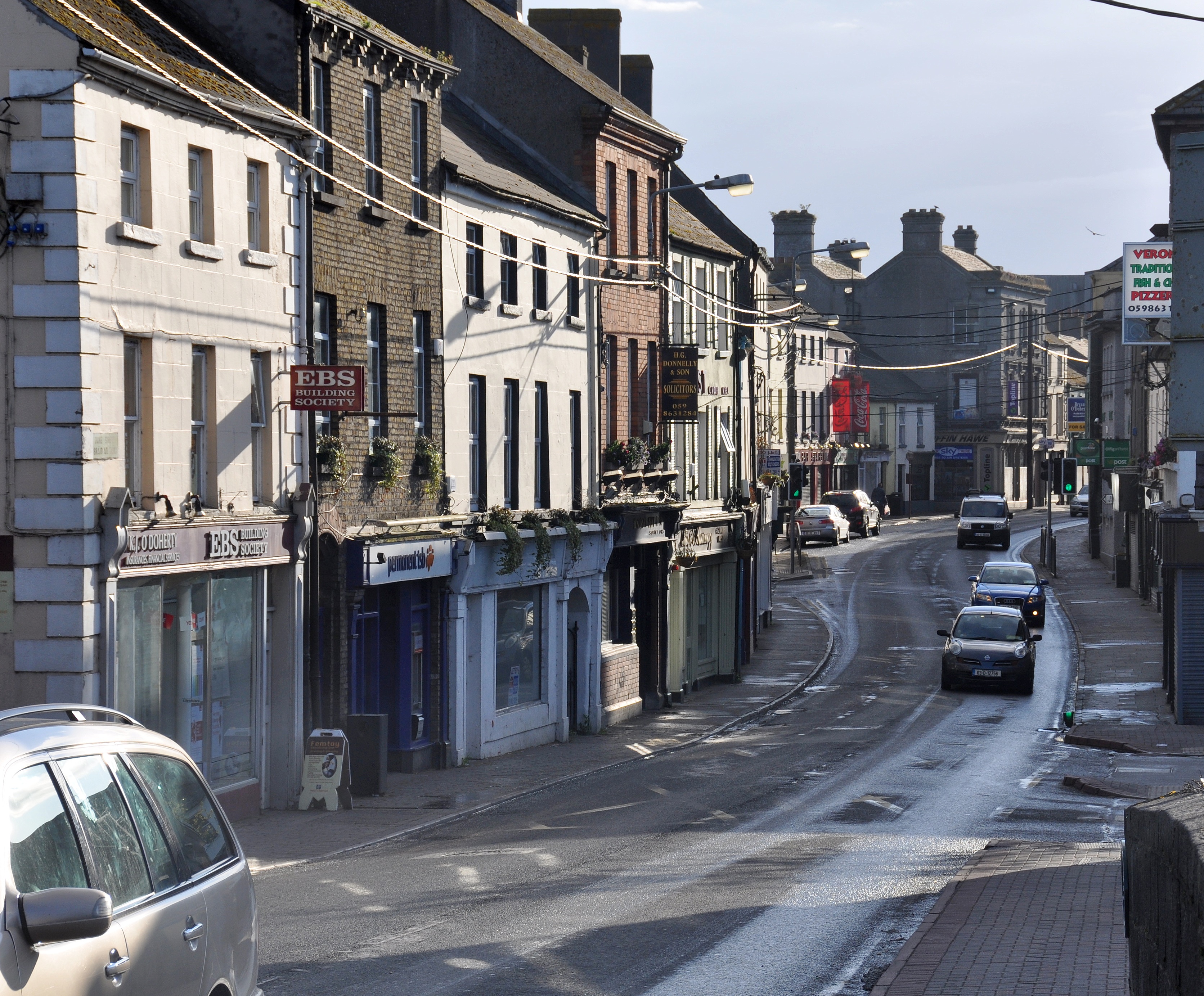|
St. Vincent's Hospital, Athy
St Vincent's Hospital, Athy () is a hospital located in Athy, Ireland. History Athy workhouse was established on the site under the Irish Poor Laws; it opened on 9 January 1844, just before the Great Famine. The Sisters of Mercy arrived as nursing sisters in 1873. In 1898, it became a County Home. 268 residents were transferred to the new St Vincent's Hospital on 3 April 1969. Services At present St Vincent's primarily provides geriatric care, including a residential care centre and day-care facilities for Alzheimer's patients. It is monitored by the Health Information and Quality Authority (HIQA). References {{Irish hospitals Hospital A hospital is a healthcare institution providing patient treatment with specialized Medical Science, health science and auxiliary healthcare staff and medical equipment. The best-known type of hospital is the general hospital, which typically ... Buildings and structures in County Kildare Hospitals in County Kildare Hospital buildi ... [...More Info...] [...Related Items...] OR: [Wikipedia] [Google] [Baidu] |
Athy
Athy ( ; ) is a market town at the meeting of the River Barrow and the Grand Canal in south-west County Kildare, Ireland, 72 kilometres southwest of Dublin. A population of 11,035 (as of the 2022 census) made it the sixth largest town in Kildare and the 45th largest in the Republic of Ireland, a growth of 82% since the 2002 census. Name Athy or is named after a 2nd-century Celtic chieftain, Ae, who is said to have been killed on the river crossing, thus giving the town its name "the town of Ae's ford". The ''Letters of the Ordnance Survey'' (1837) note that "The town is now called by the few old people who speak Irish there and in the Queen's County /nowiki>Laois">Laois.html" ;"title="/nowiki>Laois">/nowiki>Laois/nowiki>, , pronounced Blahéé", where ''éé'' stands for English 'ee' [i:] as clarified by a note written in pencil in Irish as ''Blá thí''. History According to Elizabethan historian William Camden, Ptolemy's map of Ireland circa 150 AD names the Rheban d ... [...More Info...] [...Related Items...] OR: [Wikipedia] [Google] [Baidu] |
Geriatrics
Geriatrics, or geriatric medicine, is a medical specialty focused on addressing the unique health needs of older adults. The term ''geriatrics'' originates from the Greek γέρων ''geron'' meaning "old man", and ιατρός ''iatros'' meaning "healer". It aims to promote health by preventing, diagnosing and treating disease in older adults. Older adults may be healthy, but they're more likely to have chronic health concerns and require more medical care. There is not a defined age at which patients may be under the care of a geriatrician, or geriatric physician, a physician who specializes in the care of older people. Rather, this decision is guided by individual patient needs and the caregiving structures available to them. This care may benefit those who are managing multiple chronic conditions or experiencing significant age-related complications that threaten quality of daily life. Geriatric care may be indicated if caregiving responsibilities become increasingly stre ... [...More Info...] [...Related Items...] OR: [Wikipedia] [Google] [Baidu] |
1969 Establishments In Ireland
1969 (Roman numerals, MCMLXIX) was a common year starting on Wednesday of the Gregorian calendar, the 1969th year of the Common Era (CE) and ''Anno Domini'' (AD) designations, the 969th year of the 2nd millennium, the 69th year of the 20th century, and the 10th and last year of the 1960s decade. Events January * January 4 – The Government of Spain hands over Ifni to Morocco. * January 5 – Ariana Afghan Airlines Flight 701 crashes into a house on its approach to London's Gatwick Airport, killing 50 of the 62 people on board and two of the home's occupants. * January 14 – USS Enterprise fire, An explosion aboard the aircraft carrier USS Enterprise (CVN-65), USS ''Enterprise'' near Hawaii kills 28 and injures 314. * January 16 – First successful docking of two crewed spacecraft in orbit and the first transfer of crew from one space vehicle to another (by a space walk) between Soviet craft Soyuz 5 and Soyuz 4. * January 18 – Failure of Soyuz 5's service module to separ ... [...More Info...] [...Related Items...] OR: [Wikipedia] [Google] [Baidu] |
Hospitals Established In 1969
A hospital is a healthcare institution providing patient treatment with specialized health science and auxiliary healthcare staff and medical equipment. The best-known type of hospital is the general hospital, which typically has an emergency department to treat urgent health problems ranging from fire and accident victims to a sudden illness. A district hospital typically is the major health care facility in its region, with many beds for intensive care and additional beds for patients who need long-term care. Specialized hospitals include trauma centers, rehabilitation hospitals, children's hospitals, geriatric hospitals, and hospitals for specific medical needs, such as psychiatric hospitals for psychiatric treatment and other disease-specific categories. Specialized hospitals can help reduce health care costs compared to general hospitals. Hospitals are classified as general, specialty, or government depending on the sources of income received. A teaching hospital campus c ... [...More Info...] [...Related Items...] OR: [Wikipedia] [Google] [Baidu] |
Buildings And Structures In County Kildare
A building or edifice is an enclosed structure with a roof, walls and windows, usually standing permanently in one place, such as a house or factory. Buildings come in a variety of sizes, shapes, and functions, and have been adapted throughout history for numerous factors, from building materials available, to weather conditions, land prices, ground conditions, specific uses, prestige, and aesthetic reasons. To better understand the concept, see ''Nonbuilding structure'' for contrast. Buildings serve several societal needs – occupancy, primarily as shelter from weather, security, living space, privacy, to store belongings, and to comfortably live and work. A building as a shelter represents a physical separation of the human habitat (a place of comfort and safety) from the ''outside'' (a place that may be harsh and harmful at times). buildings have been objects or canvasses of much artistic expression. In recent years, interest in sustainable planning and building practi ... [...More Info...] [...Related Items...] OR: [Wikipedia] [Google] [Baidu] |
Health Information And Quality Authority
The Health Information and Quality Authority (HIQA, ; ) is a statutory, government-funded agency in Ireland which monitors the safety and quality of the healthcare and social care systems. Mooted as early as 2001, HIQA received its powers and mandate in May 2007 under the Health Act 2007. The Authority also exercises functions under the Child Care Act 1991 and the Children Act 2001. Hospitals The Authority has produced a number of reports and recommendations on the safety of care in both public and private hospitals. HIQA is also tasked with inspecting hygiene standards in public hospitals. As well as performing hospital evaluations, HIQA is charged with implementing electronic health records and information governance, investigating waiting times, and protecting whistleblowers. Nursing homes After the Leas Cross scandal, there was increased demand for inspection of both private and public nursing homes. As a result, HIQA was given powers to register, inspect and, via applic ... [...More Info...] [...Related Items...] OR: [Wikipedia] [Google] [Baidu] |
Alzheimer's
Alzheimer's disease (AD) is a neurodegenerative disease and the cause of 60–70% of cases of dementia. The most common early symptom is difficulty in remembering recent events. As the disease advances, symptoms can include problems with language, disorientation (including easily getting lost), mood swings, loss of motivation, self-neglect, and behavioral issues. As a person's condition declines, they often withdraw from family and society. Gradually, bodily functions are lost, ultimately leading to death. Although the speed of progression can vary, the average life expectancy following diagnosis is three to twelve years. The causes of Alzheimer's disease remain poorly understood. There are many environmental and genetic risk factors associated with its development. The strongest genetic risk factor is from an allele of apolipoprotein E. Other risk factors include a history of head injury, clinical depression, and high blood pressure. The progression of the dis ... [...More Info...] [...Related Items...] OR: [Wikipedia] [Google] [Baidu] |
County Kildare
County Kildare () is a Counties of Ireland, county in Ireland. It is in the Provinces of Ireland, province of Leinster and is part of the Eastern and Midland Region. It is named after the town of Kildare. Kildare County Council is the Local government in the Republic of Ireland, local authority for the county, which had a population of 246,977 at the 2022 census. Geography and subdivisions Kildare is the 24th-largest of Ireland's 32 counties in area and the seventh-largest in terms of population. It is the eighth largest of Leinster's twelve counties in size, and the second largest in terms of population. It is bordered by the counties of County Carlow, Carlow, County Laois, Laois, County Meath, Meath, County Offaly, Offaly, South Dublin and County Wicklow, Wicklow. As an inland county, Kildare is generally a lowland region. The county's highest points are the foothills of the Wicklow Mountains bordering to the east. The highest point in Kildare is Cupidstown Hill on the border w ... [...More Info...] [...Related Items...] OR: [Wikipedia] [Google] [Baidu] |
Sisters Of Mercy
The Sisters of Mercy is a religious institute for women in the Catholic Church. It was founded in 1831 in Dublin, Ireland, by Catherine McAuley. In 2019, the institute had about 6,200 Religious sister, sisters worldwide, organized into a number of independent Religious congregation, congregations. Notable achievements include the foundation of education and health care facilities, around the world. History Founding The Congregation of the Sisters of Mercy began when Catherine McAuley used an inheritance to build a large house on Baggot Street, Dublin, as a school for poor girls and a homeless shelter for servant girls and women. Local women assisted in the works of the house. There was no idea then of founding a religious institution; McAuley's plan was to establish a society of secular ladies who would spend a few hours daily in instructing the poor. Gradually the ladies adopted a black dress and cape of the same material reaching to the belt, a white collar and a lace cap an ... [...More Info...] [...Related Items...] OR: [Wikipedia] [Google] [Baidu] |






